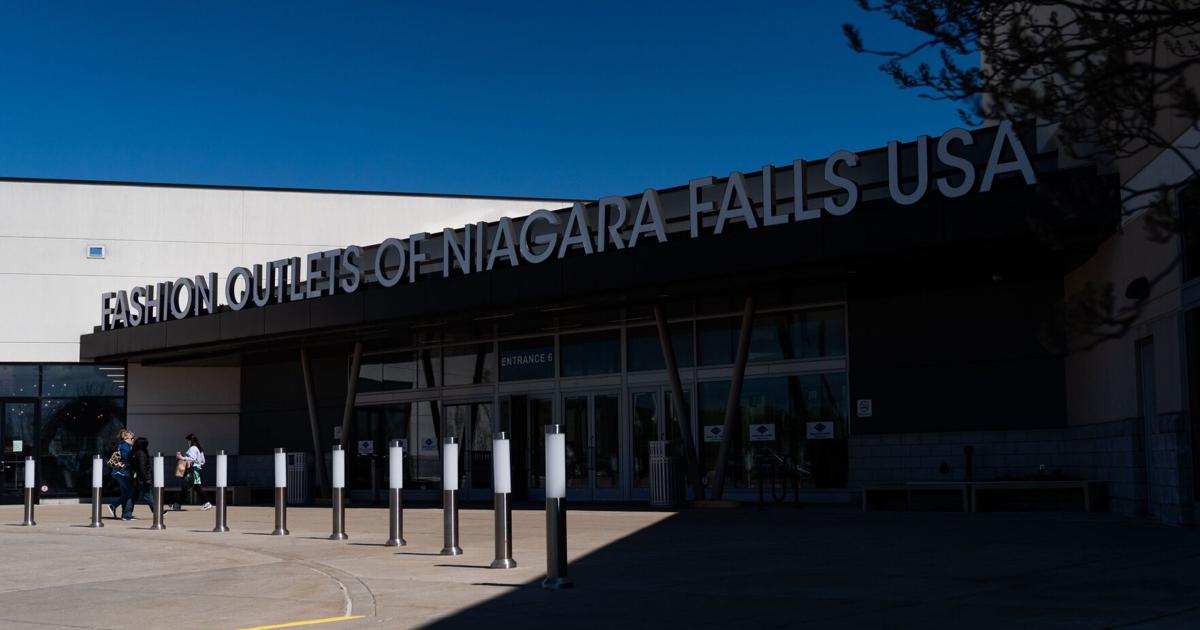When California-based Macerich Co. bought the Fashion Outlets of Niagara Falls USA for $200 million in 2010, it was a different world.
The Canadian dollar was at par, bringing droves of Canadian shoppers across the border each weekend to empty their wallets and fill their trunks with mall purchases. Those Canadians also faced a dearth of shopping options, a lack of variety and high prices at their own stores that made Fashion Outlets particularly enticing.
Shoppers on both sides of the border were crazy for designer names and Fashion Outlets had them all – the labels splashed across sweatshirts and handbags. The center was almost fully occupied and had a list of tenants waiting to get in.
An $85 million loan on the mall defaulted and went to a special servicer in October.
People are also reading…
Canadian border crossing numbers are down and haven’t returned to what they were before Covid. The Outlet Collection at Niagara-on-the-Lake, which opened in 2014, retains more shoppers in Ontario.
Shoppers peruse a deal at the Fashion Outlets of Niagara Falls.
Shopping habits have changed, too, with consumers shunning the ostentatious display of designer names and looking for better quality and value.
The supply chain has changed, with fewer closeout goods making it to outlet malls. And the occupancy rate at Fashion Outlets has dropped to 78%.
At Macerich properties overall, sales were down 1.8% for the year.
“Spending across all retail categories in 2023 was clouded with increasing interest rates, inflation and the constant threat of a recession,” said Doug Healey, senior executive vice president of leasing, during the company’s earnings call in February.
Macerich Co. did not return requests for comment. But as Fashion Outlets navigates a variety of headwinds, here are some of the unique challenges it is facing.

People relax in a seating area at the Fashion Outlets of Niagara Falls. Several high-profile brands like Disney and Perry Ellis have closed stores initially heralded as part of a 2014 expansion project.
Canadian complications
Foremost, the Fashion Outlets is struggling without the support it once enjoyed from cross-border Canadian shoppers. Border crossing numbers from Ontario to the Buffalo Niagara region still haven’t recovered to pre-Covid strength, according to the U.S. Department of Transportation Bureau of Transportation Statistics.
At the same time, the U.S. dollar is the strongest it has been in about a decade. With the Canadian exchange rate at about 72 cents, Canadian shoppers find themselves with less buying power on our side of the border.
The Outlet Collection at Niagara-on-the-Lake, a sprawling outlet mall in Ontario, now provides the brands and variety that could once only be found in the United States, giving Canadians one more reason to shop in their own country.
Canadians are also being squeezed financially, and trips to Fashion Outlets of Niagara Falls are no longer the relief they once were, said Burt Flickinger III, a retail expert and founder of Strategic Resource Group in New York City.
“The Canadians are under unprecedented pressure for inflation on one side and devaluation of the Canadian dollar on the other side,” Flickinger said.

The Fashion Outlets of Niagara Falls, purchased in 2010 for $200 million, is confronting a raft of challenges brought on by changes in cross-border consumer habits and supply chain complications that still reverberate in the wake of Covid-19.
Supply chain changes
More brands have moved to “just-in-time” manufacturing, where production is paced to meet demand rather than to create a surplus in advance of what might be needed.
“The Asian manufacturers and the Central and Latin American manufacturers are stretched on working capital, so they’re producing less inventory,” Flickinger said.
With Macy’s and J.C. Penney continuing to close stores, they’re doing their own merchandise closeouts, Flickinger said. Among what closeouts there are, TJ Maxx and Marshalls parent TJX Stores is getting first dibs.
“TJX is getting first call on the clothes and so TJ Maxx, Marshalls, Homegoods and Homesense are getting it in their traditional or legacy stores,” Flickinger said. “They’re getting the best, lowest-priced inventory first, which is leaving less for the Fashion Outlets.”
And increasingly over the years, outlet malls have ceased being true outlets, with brands creating secondary lines of lower-priced name brand merchandise specifically for outlet malls.
Changing shopper habits
For years, outlet malls have been insulated from the woes of traditional malls, partly because they offered name brand designers at more affordable prices, and those designer names were sought after by shoppers who liked to show them off.
But fashion trends have since turned away from flashy labels and become more understated and sustainable. That’s especially the case as more consumers turn toward thrift stores amid high inflation, Flickinger said.
“Thrift stores are selling some of the finest quality fashion for men’s, women’s, boys’ and girls’ wear for literally pennies on the dollar,” Flickinger said. “And what’s being sold in the thrift stores today is oftentimes better tailored, better quality, better materials, than what the department stores and discount stores are selling.”
At the same time, consumers’ “closets are stuffed,” he said. With obesity rates at record highs after Covid, many shoppers are holding off on buying new clothing until they lose weight, Flickinger said.
And while malls like Walden Galleria and even other Macerich properties have made a conscious effort to pivot to more restaurant and entertainment uses, Fashion Outlets remains heavy on clothing and footwear.
“We’ve definitely seen a change in spending habits,” said Healey in the earnings call. “Consumers are now focusing on travel, dining out, entertainment and other various services.”

Experts says the Fashion Outlets of Niagara Falls is likely missing out on potential Canadian customers who are now trapped between market forces of “inflation on one side and devaluation of the Canadian dollar on the other side.”
A high vacancy rate
The Fashion Outlets’ occupancy rate sits at 78%, according to Trepp, a commercial real estate research firm. That’s down from 93% in 2010.
In 2014, the mall added a $71 million expansion, adding 175,000 square feet of new shopping space. At the time, analysts wondered if it wasn’t a bad move, built on an artificially high number of cross-border shoppers brought by an atypically high exchange rate.
And in the years since the expansion was finished, several of the 30 new stores that opened to occupy the new wing have closed, including Disney, Helly Hanson, Perry Ellis, Dress Barn and Sperry Top-Sider.
While other Macerich shopping centers have seen record leasing numbers and a strong leasing pipeline of successful stores, Fashion Outlets of Niagara Falls has lagged behind in quality and quantity.
“It’s tough,” Flickinger said.
As long as occupancy stays above 73% to 75% occupancy, most current AA- and AAA-credit-rated tenants will stay at the mall and give the owners an opportunity to attract new tenants, Flickinger said.
“But if it’s at the same level 12 months from now, that would significantly increase the uncertainty for the rest of this decade going forward,” he said.
Loan troubles
In October, Macerich defaulted on an $86 million loan on the Fashion Outlets of Niagara Falls, which was sent to a special servicer. Macerich is working with its loan servicer on a multiyear extension.
“Over the past few months we have made considerable progress addressing our debt maturities,” then-CEO Thomas O’Hern said in the earnings call in February.
That Macerich decided to salvage the mall and refinance the loan was a surprise to some analysts. That was especially the case considering Macerich had previously put the mall up for sale.
“The asset still does generate some (funds from operations). It certainly has its challenges given its market positioning with north of the border in Canada and the local market,” Scott Kingsmore, chief financial officer, said on the call. “There still is some opportunity for that asset, and we’ll continue to capitalize on those opportunities.”











